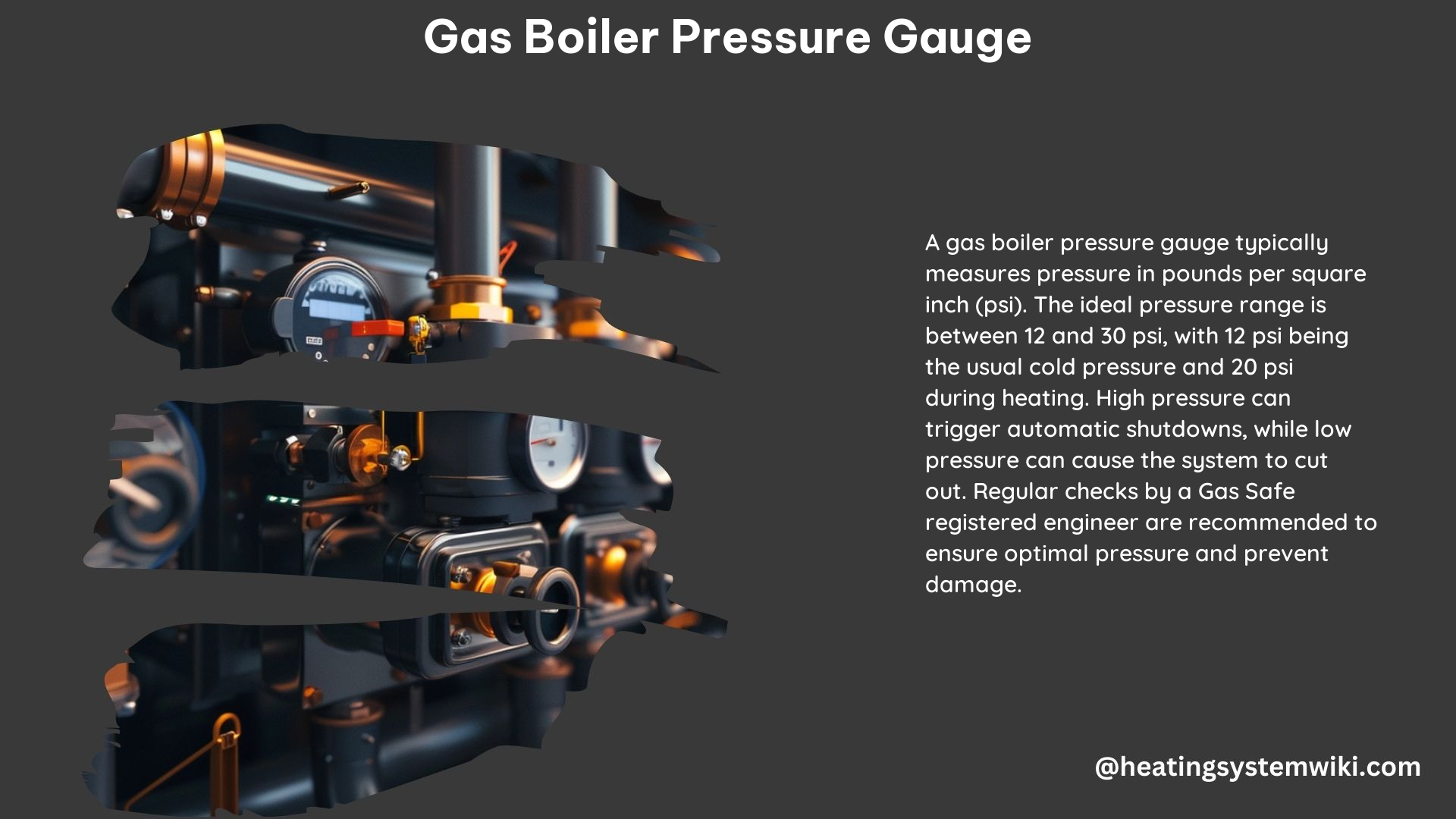A gas boiler pressure gauge is a critical component in ensuring the safe and efficient operation of a boiler system. This comprehensive guide delves into the intricate details and technical specifications of gas boiler pressure gauges, providing a valuable resource for homeowners, HVAC technicians, and DIY enthusiasts.
Functionality and Importance
The primary function of a gas boiler pressure gauge is to measure the pressure of the hot water within the sealed system. This gauge is typically located on the front of the boiler and features a dial with a green and red section, indicating the optimal pressure range. The correct pressure range for most boilers is between 1 and 1.5 bar, ensuring the system operates at the manufacturer’s recommended levels.
Maintaining the proper boiler pressure is crucial for several reasons:
- Safety: Excessive pressure can lead to the risk of boiler explosions, which can cause severe damage and pose a significant threat to life and property. Conversely, low pressure can result in the boiler shutting down, leading to a loss of heating and hot water.
- Efficiency: Optimal boiler pressure ensures the efficient transfer of heat, maximizing the system’s performance and reducing energy consumption.
- Longevity: Maintaining the correct pressure range can extend the lifespan of the boiler and its components, reducing the need for costly repairs or replacements.
Types of Gauges

Gas boiler pressure gauges come in various types, each with its own unique features and applications:
- Tridicators: These gauges measure both pressure and temperature on the same dial face using independent pointers and scales. Tridicators are commonly used on heating systems and boilers, providing a comprehensive view of the system’s vital parameters.
- Dial Pressure Gauges: These gauges measure positive system pressure starting at zero, typically in psi (pounds per square inch) units. Dial pressure gauges are available in different sizes and connection types, such as NPT (National Pipe Thread) male fittings.
- High-Accuracy Gauges: Designed for boiler and control rooms, these gauges offer exceptional accuracy and precision, often with an accuracy rating of ±3-2-3% or better. These high-end gauges are essential for critical applications where precise pressure monitoring is required.
Technical Specifications
When selecting a gas boiler pressure gauge, it’s important to consider the following technical specifications:
- Pressure Range: Common pressure ranges for gas boiler pressure gauges include 0-75 PSI, 0-160 PSI, and 0-200 PSI, allowing for accurate monitoring of a wide variety of boiler systems.
- Temperature Range: Typical temperature ranges for gas boiler pressure gauges are 30-250°F and 70-320°F/C, ensuring compatibility with the operating temperatures of most boiler systems.
- Connection Types: Gas boiler pressure gauges are available with various connection types, such as 1/4″ NPT male, 1/2″ NPT male, 1/4″ x 1/2″ NPT, and 1/4″ x 3/8″ NPT hex bushing, allowing for easy integration with different boiler configurations.
- Accuracy: High-accuracy gas boiler pressure gauges can offer an impressive ±3-2-3% accuracy rating, providing precise pressure readings for critical applications.
Installation and Maintenance
Proper installation and regular maintenance of the gas boiler pressure gauge are essential for ensuring accurate readings and safe system operation. When installing or replacing a gauge, it’s crucial to follow the manufacturer’s instructions carefully, as improper installation can lead to inaccurate readings or even safety hazards.
Maintenance tasks for gas boiler pressure gauges include:
- Checking for Leaks: Regularly inspect the gauge and its connections for any signs of leaks, which can affect the pressure readings and potentially lead to system failures.
- Verifying Expansion Vessel Function: Ensure the expansion vessel, which helps maintain the correct pressure in the system, is functioning correctly. Any issues with the expansion vessel can impact the boiler pressure.
- Calibration and Replacement: Periodically check the gauge’s calibration and replace it if necessary to maintain accurate pressure readings. High-accuracy gauges may require more frequent calibration.
DIY Considerations
While some homeowners may feel confident in installing or replacing a gas boiler pressure gauge, it’s generally recommended to consult a professional HVAC technician if you are not familiar with the process. Improper installation can lead to inaccurate readings, system malfunctions, and even safety hazards.
If you do decide to tackle the task yourself, be sure to have the necessary tools and follow the manufacturer’s instructions closely. Additionally, it’s crucial to understand the specific requirements and regulations in your local area, as they may vary and impact the installation process.
Conclusion
The gas boiler pressure gauge is a vital component in ensuring the safe and efficient operation of a boiler system. By understanding the functionality, types, technical specifications, installation, and maintenance requirements of these gauges, you can take proactive steps to maintain your boiler’s performance and extend its lifespan. Remember, when in doubt, it’s always best to consult a professional HVAC technician to ensure the job is done correctly and safely.
References
- Grainger Industrial Supply. (n.d.). HVAC & Boiler Gauges. Retrieved from https://www.grainger.com/category/test-instruments/pressure-vacuum-measurement/pressure-vacuum-gauges/hvac-boiler-gauges
- Amazon.com. (n.d.). Boiler Temperature Pressure Gauge. Retrieved from https://www.amazon.com/boiler-temperature-pressure-gauge/s?k=boiler+temperature+pressure+gauge
- Blue Ribbon Corp. (n.d.). Model BRPT Boiler Gauge/Tridicator. Retrieved from https://blueribboncorp.com/product/model-brpt-boiler-gauge-tridicator/
- Amazon.com. (n.d.). Boiler Temperature Pressure Gauge. Retrieved from https://www.amazon.com/boiler-temperature-pressure-gauge/s?k=boiler+temperature+pressure+gauge&page=2
- Viessmann UK. (2022, April 5). How to read a boiler pressure gauge. Retrieved from https://www.viessmann.co.uk/en/heating-advice/boilers/how-to-read-a-boiler-pressure-gauge.html
